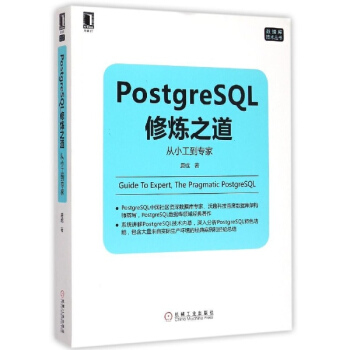![Python3面向对象编程(第2版 影印版 英文版) [Python 3 object-oriented Programming Second Edition]](https://pic.windowsfront.com/12196728/591d4d9cN4f32591e.jpg)

具体描述
内容简介
《Python3面向对象编程(第2版 影印版 英文版)》讲解了类、数据封装、继承、多态、抽象和异常,着重强调了在一款设计良好的软件开发过程中使用每个原则的时机。除了学习如何利用高层次的设计模式来创建可维护的应用程序,你还可以了解到字符串和文件处理的复杂性以及Python区分二进制数据和文本数据的方法。另外,单元测试的乐趣以及并发编程的难题也是少不了的。书中更新了大量的内容,以反映出近来核心Python库的变化,这些新的特性在《Python3面向对象编程(第2版 影印版 英文版)》备受赞誉的第1版面世时还无法使用。除此之外,全书的结构也进行了重新调整和组织,提升了知识量,增强了阅读体验。
目标读者如果你是初次接触面向对象编程技术,或是只具备基本的Python技能,希望能够深入学习如何正确地使用Python面向对象编程技术来设计软件,那么《Python3面向对象编程(第2版 影印版 英文版)》就是为你准备的。
你将从《Python3面向对象编程(第2版 影印版 英文版)》中学到什么通过创建类和定义方法来实现Python对象。
将相关的对象划分成不同的类,通过类接口来描述这些对象的属性和行为。
使用继承来扩展类的功能。
明白什么时候使用面向对象特性,什么时候不使用(后者更重要)。
了解什么是设计模式,为什么在Python中有这些不同的设计模式。
揭示单元测试的简洁性及其在Python中的重要性。
理解Python3中常见的并发编程技术和陷阱。
探究用于开发大规模并发网络系统的新模块Async10。
作者简介
Dusty Phillips,is a Canadian software developer and author currently living in Seattle, Washington. He has been active in the open source community for a decade and a half and programming in Python for nearly all of it. He cofounded the popular Puget Sound Programming Python meetup group; drop by and say hi if you're in the area.目录
PrefaceChapter 1: Object-oriented Desiqn
Introducing object-oriented
Objects and classes
Specifying attributes and behaviors
Data describes objects
Behaviors are actions
Hiding details and creating the public interface
Composition
Inheritance
Inheritance provides abstraction
Multiple inheritance
Case study
Exercises
Summary
Chapter 2: Objects in Python
Creating Python classes
Adding attributes
Making it do something
Talking to yourself
More arguments
Initializing the object
Explaining yourself
Modules and packages
Organizing the modules
Absolute imports
Relative imports
Organizing module contents
Who can access my data?
Third-party libraries
Case study
Exercises
Summary
Chapter 3: When Objects Are Alike
Basic inheritance
Extending built-ins
Overriding and super
Multiple inheritance
The diamond problem
Different sets of arguments
Polymorphism
Abstract base classes
Using an abstract base class
Creating an abstract base class
Demystifying the magic
Case study
Exercises
Summary
Chapter 4: Expecting the Unexpected
Raising exceptions
Raising an exception
The effects of an exception
Handling exceptions
The exception hierarchy
Defining our own exceptions
Case study
Exercises
Summary
Chapter 5: When to Use Object-oriented Programming
Treat objects as objects
Adding behavior to class data with properties
Properties in detail
Decorators - another way to create properties
Deciding when to use properties
Manager objects
Removing duplicate code
In practice
Case study
Exercises
Summary
Chapter 6: Python Data Structures
Empty objects
Tuples and named tuples
Named tuples
Dictionaries
Dictionary use cases
Using defaultdict
Counter
Lists
Sorting lists
Sets
Extending built-ins
Queues
FIFO queues
LIFO queues
Priority queues
Case study
Exercises
Summary
Chapter 7: Python Object-oriented Shortcuts
Python built-in functions
The len() function
Reversed
Enumerate
File I/O
Placing it in context
An alternative to method overloading
Default arguments
Variable argument lists
Unpacking arguments
Functions are objects too
Using functions as attributes
Callable objects
Case study
Exercises
Summary
Chapter 8: Strings and Serialization
Strings
String manipulation
String formatting
Escaping braces
Keyword arguments
Container Iookups
Object Iookups
Making it look right
Strings are Unicode
Converting bytes to text
Converting text to bytes
Mutable byte strings
Regular expressions
Matching patterns
Matching a selection of characters
Escaping characters
Matching multiple characters
Grouping patterns together
Getting information from regular expressions
Making repeated regular expressions efficient
Serializing objects
Customizing pickles
Serializing web objects
Case study
Exercises
Summary
Chapter 9: The Iterator Pattern
Design patterns in brief
Iterators
The iterator protocol
Comprehensions
List comprehensions
Set and dictionary comprehensions
Generator expressions
Generators
Yield items from another iterable
Coroutines
Back to log parsing
Closing coroutines and throwing exceptions
The relationship between coroutines, generators, and functions
Case study
Exercises
Summary
Chapter 10: Python Design Patterns I
The decorator pattern
A decorator example
Decorators in Python
The observer pattern
An observer example
The strategy pattern
A strategy example
Strategy in Python
The state pattern
A state example
State versus strategy
State transition as coroutines
The singleton pattern
Singleton implementation
The template pattern
A template example
Exercises
Summary
Chapter 11: Python Design Patterns II
The adapter pattern
The facade pattern
The flyweight pattern
The command pattern
The abstract factory pattern
The composite pattern
Exercises
Summary
Chapter 12: Testing Object-oriented Programs
Why test?
Test-driven development
Unit testing
Assertion methods
Reducing boilerplate and cleaning up
Organizing and running tests
Ignoring broken tests
Testing with py.test
One way to do setup and cleanup
A completely different way to set up variables
Skipping tests with py.test
Imitating expensive objects
How much testing is enough?
Case study
Implementing it
Exercises
Summary
Chapter 13: Concurrency
Threads
The many problems with threads
Shared memory
The global interpreter lock
Thread overhead
Multiprocessing
Multiprocessing pools
Queues
The problems with multiprocessing
Futures
AsynclO
AsynclO in action
Reading an AsynclO future
AsynclO for networking
Using executors to wrap blocking code
Streams
Executors
Case study
Exercises
Summary
Index
用户评价
这本《Python 3面向对象编程(第2版 影印版 英文版)》真是让我眼前一亮,翻开它,我就被那种严谨又不失灵活的编程思想深深吸引了。虽然我是一名Python爱好者,但对于面向对象编程(OOP)的理解一直有些模糊,总觉得那些“类”、“对象”、“继承”、“多态”的概念像是空中楼阁,难以落地。这本书恰恰填补了我的这个知识空白。它没有上来就抛出一堆晦涩难懂的术语,而是循序渐进地从最基础的概念讲起,用大量的图示和生动形象的比喻来解释抽象的原理。我尤其喜欢书中关于“封装”的讲解,作者通过一个模拟现实世界场景的例子,将“数据”和“操作数据的方法”打包在一起,让我瞬间明白了封装的真正意义在于提高代码的可维护性和安全性。接着,关于“继承”,书中通过一个家族谱系的比喻,生动地展示了如何利用现有类的基础上创建新类,这让我体会到了代码复用的强大力量。更让我惊喜的是,本书并没有止步于理论,而是提供了大量的实践项目,涵盖了从简单的图形界面应用到复杂的数据结构设计,让我能够在动手实践中巩固所学,真正做到学以致用。每一章的结尾都有一些挑战性的练习题,虽然一开始会觉得有些吃力,但当我最终解决问题时,那种成就感是无与伦比的。这本书就像一位耐心细致的良师益友,带领我在Python的OOP世界里稳步前行。
评分作为一名在软件开发领域摸爬滚打了多年的开发者,我对编程语言的深度和广度有着自己的理解。这次接触到《Python 3面向对象编程(第2版 影印版 英文版)》,我首先关注的是它是否能够提供更深层次的洞察,而不仅仅是表面上的语法介绍。事实证明,我的担忧是多余的。这本书在对Python OOP核心概念的阐释上,有着令人耳目一新的深度。例如,在讨论“多态”时,作者并没有停留在简单的函数重写,而是深入剖析了其在设计模式中的应用,例如“策略模式”和“工厂模式”,展示了多态如何能够极大地提升代码的灵活性和可扩展性,使程序能够在运行时动态地选择不同的行为。此外,书中对“抽象基类”(Abstract Base Classes)的讲解也尤为精彩,它不仅介绍了如何定义和使用ABC,还探讨了其在构建大型、健壮系统时的重要性,如何强制实现接口,保证了不同组件之间的兼容性。我特别欣赏的是,作者在讲解过程中,始终强调“Pythonic”的风格,以及如何利用Python的特性(如装饰器、元类)来更好地实现OOP设计。书中提供的代码示例,清晰、简洁且极具指导意义,充分展示了如何写出既符合OOP原则又兼具Python特色的优雅代码。这本书对于想要精进Python OOP技能的开发者来说,绝对是不可多得的宝藏。
评分我原本以为学习面向对象编程会是一件枯燥乏味的事情,毕竟那些抽象的概念总是让人望而却步。《Python 3面向对象编程(第2版 影印版 英文版)》彻底改变了我的看法。这本书以一种非常有趣且引人入胜的方式,将复杂的OOP概念变得易于理解。它将编程比作“构建乐高积木”,每个类都是一块积木,你可以通过组合不同的积木来创造出更复杂的结构。这种生动的类比让我立刻对OOP产生了亲近感。书中对于“类”和“对象”的解释,就像在教我们如何定义一个“蓝图”,然后根据这个蓝图制造出具体的“产品”。我尤其喜欢书中关于“属性”和“方法”的讲解,它就像在描述一个产品的“特征”和“功能”。通过大量的图文并茂的示例,我得以亲眼见证如何在一个类中定义属性来存储数据,如何定义方法来执行操作。而且,本书并非止步于理论,它提供了许多有趣的实战案例,比如创建一个简单的“宠物”模拟程序,让每个宠物都有自己的名字、年龄和叫声,这让我觉得编程不再是冷冰冰的代码,而是充满生命力的创造过程。这本书让我体会到了OOP的乐趣,也激发了我进一步探索Python OOP世界的浓厚兴趣。
评分在我的编程生涯中,我接触过不少关于Python的书籍,但《Python 3面向对象编程(第2版 影印版 英文版)》给我留下了深刻的印象。这本书的结构设计非常合理,从基础概念的引入,到高级特性的深入探讨,都显得游刃有余。我特别欣赏的是,作者在讲解每一个OOP概念时,都会将其置于实际的编程场景中,而不是孤立地解释。比如,在介绍“组合”时,书中展示了如何通过将一个对象的实例作为另一个对象的属性来构建更复杂的系统,这种“has-a”关系的处理方式,比我之前理解的“继承”(is-a)更加灵活和强大,为解决现实世界中的复杂问题提供了新的思路。此外,书中对“设计模式”的引入,更是让我眼前一亮。它不仅仅是罗列了几种常见的设计模式,而是深入分析了每种模式背后的设计思想和应用场景,例如“单例模式”在全局配置管理中的应用,“观察者模式”在事件驱动编程中的运用,这些都极大地开阔了我的视野,让我开始从“如何编码”转变为“如何设计”,如何写出更健壮、更易于维护的代码。这本书真正做到了授人以渔,让我不仅学会了Python的OOP语法,更掌握了OOP的设计精髓。
评分我一直对Python的灵活性和简洁性赞不绝口,而《Python 3面向对象编程(第2版 影印版 英文版)》则让我看到了Python在面向对象编程方面所展现出的独特魅力。这本书没有使用晦涩的语言,而是以一种非常平实的口吻,娓娓道来。从创建第一个简单的类开始,它就引导读者一步步构建更加复杂的OOP结构。我印象最深刻的是书中关于“特殊方法”(Special Methods,也称为魔术方法)的讲解,比如`__init__`、`__str__`、`__len__`等等。作者通过丰富的例子,展示了如何利用这些特殊方法来定制类的行为,让Python对象能够像内置类型一样进行操作,例如直接使用`len()`函数获取对象的长度,或者使用`print()`函数方便地输出对象的信息。这种“Pythonic”的编程方式,让我觉得Python的OOP不仅仅是模仿其他语言的模式,而是拥有自己独特的哲学。此外,书中还探讨了“生成器”(Generators)和“迭代器”(Iterators)在OOP中的应用,这对于处理大量数据或者需要惰性计算的场景非常有用,让我对Python的内存管理和性能优化有了更深的理解。总而言之,这本书就像一位经验丰富的向导,带领我深入探索Python OOP的每一个角落,让我对其有了更加全面和深刻的认识。
评分还没来得及看内容,不过纸张很一般,很一般,很一般…
评分学习中
评分娘子,啊哈!
评分还没来得及看内容,不过纸张很一般,很一般,很一般…
评分学习中
评分Good ... Good ...Good ... Good ...Good ... Good ...Good ... Good ...
评分东西不错,已经收到。正在使用,满意。
评分娘子,啊哈!
评分还没来得及看内容,不过纸张很一般,很一般,很一般…
相关图书
本站所有内容均为互联网搜索引擎提供的公开搜索信息,本站不存储任何数据与内容,任何内容与数据均与本站无关,如有需要请联系相关搜索引擎包括但不限于百度,google,bing,sogou 等,本站所有链接都为正版商品购买链接。
© 2025 windowsfront.com All Rights Reserved. 静流书站 版权所有

















![应用计算智能:如何创造价值 [Applying Computational Intelligence How to Create Value] pdf epub mobi 电子书 下载](https://pic.windowsfront.com/12047128/58089188N175cf990.jpg)


![Android 6 应用开发案例精解(第三版) [Android 6 for Programmers: An App-Driven Approach,] pdf epub mobi 电子书 下载](https://pic.windowsfront.com/12084243/59285711N6b2ea421.jpg)